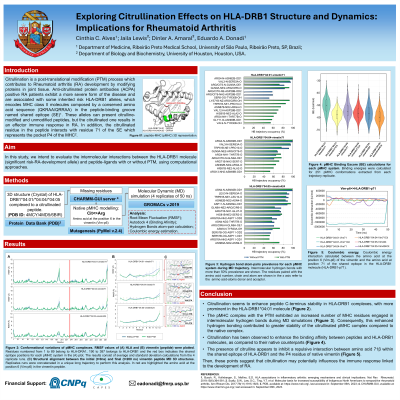Back

Exploring the Citrullination Effects on the HLA-DRB1 Structure and Dynamics: Implications for the Rheumatoid Arthritis Pathogenesis
(P118) Exploring the citrullination effects on the HLA-DRB1 structure and dynamics
Location: Platinum Ballroom

Poster Presenter(s)
Aim: Citrullination is a post-translational modification (PTM) process, which contributes to rheumatoid arthritis (RA) development by modifying proteins in joint tissue, particularly among smokers. RA patients with anti-citrullinated protein antibodies (ACPA) exhibit a more severe form of the disease, and ACPA production has been associated with inherited HLA-DRB1 risk alleles, particularly those containing a conserved amino acid sequence (QKRAA/QRRAA) in the peptide-binding groove, known as the RA-shared epitope. These alleles can present citrulline-modified and unmodified peptides, but the citrullinated ones result in a pathogenic immune response in RA. We evaluated the intermolecular interactions between the HLA-DRB1 molecule (risk-factor for RA-associated development) and peptide-ligands presenting or not citrullination as PTMs, using computational approaches.
Method: The crystals structures of the HLA-DRB1*04:01/*04:04/*04:05 molecules bound to a vimentin-citrullinated peptide were recovered from the Protein Data Bank (PDB IDs: 4MCY/4MD5/6BIR, respectively). These crystals were also used to obtain the peptide-HLA (pHLA) structure with the native peptide. The citrulline residue in the peptide, observed at the P4-residue that interacts with the shared epitope in the binding groove, was mutated to arginine using the Mutagenesis tool on PyMol v.2.4 software. The pHLA complexes were submitted to 4 rounds (50 ns) of molecular dynamic simulations (MD) using Gromacs v. 2019.
Results: The presence of citrulline inhibited the repulsive interaction between the 71β amino acid (lysine for the HLA-DRB1*04:01 and arginine for the *04:04/*04:05) within the shared epitope of HLA-DRB1 and the P4 residue of native vimentin. Furthermore, the pHLA complex with this PTM exhibited an increased number of HLA residues engaged in intermolecular hydrogen bonds during MD simulations. Consequently, this enhanced hydrogen bonding contributed to greater stability of the citrullinated pHLA complex compared to the native complex.
Conclusion: Citrullination affects both the binding affinity and the dynamics of the pHLA complexes, potentially influencing the immune response associated with the development of RA.
Method: The crystals structures of the HLA-DRB1*04:01/*04:04/*04:05 molecules bound to a vimentin-citrullinated peptide were recovered from the Protein Data Bank (PDB IDs: 4MCY/4MD5/6BIR, respectively). These crystals were also used to obtain the peptide-HLA (pHLA) structure with the native peptide. The citrulline residue in the peptide, observed at the P4-residue that interacts with the shared epitope in the binding groove, was mutated to arginine using the Mutagenesis tool on PyMol v.2.4 software. The pHLA complexes were submitted to 4 rounds (50 ns) of molecular dynamic simulations (MD) using Gromacs v. 2019.
Results: The presence of citrulline inhibited the repulsive interaction between the 71β amino acid (lysine for the HLA-DRB1*04:01 and arginine for the *04:04/*04:05) within the shared epitope of HLA-DRB1 and the P4 residue of native vimentin. Furthermore, the pHLA complex with this PTM exhibited an increased number of HLA residues engaged in intermolecular hydrogen bonds during MD simulations. Consequently, this enhanced hydrogen bonding contributed to greater stability of the citrullinated pHLA complex compared to the native complex.
Conclusion: Citrullination affects both the binding affinity and the dynamics of the pHLA complexes, potentially influencing the immune response associated with the development of RA.

